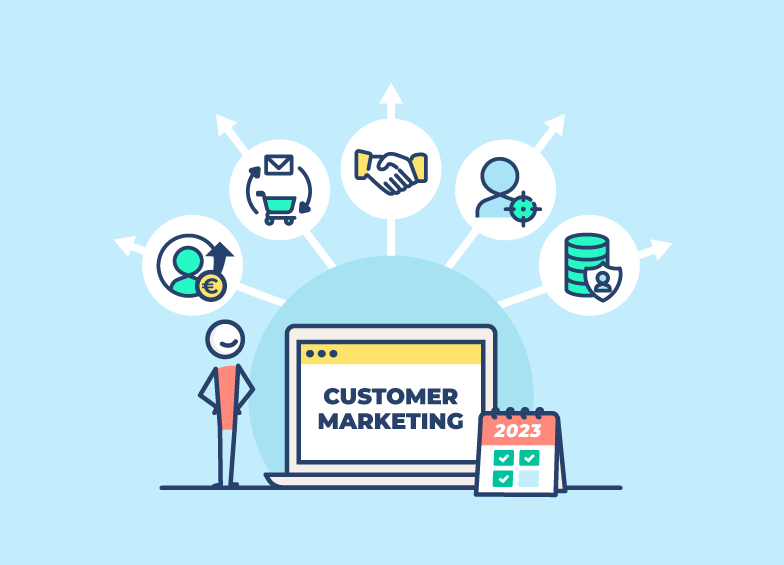The 5 evolutions of customer marketing to operate in 2023



Nathalie Remi-Beauce
Category: CRM strategy
It's a fact: in 2023, your customers will be more thoughtful and careful about their spending.
To keep up with the competition, you'll need to redouble your imagination and make things easier for customers at every stage of the buying process: streamlining the customer experience and the act of buying on the e-commerce site, digitalizing points of sale (QR codes, contactless payment...), inviting virtual reality and social networks online and in-store... Agility, adaptability and digitalization will undoubtedly be major differentiators for brands in a tense market.
As far as CRM is concerned, the customer inevitably becomes the primary (and even the only!) issue of the year. Customers will have to make trade-offs, so we'll have to make sure we get to know them better, engage them better and make the buying process easier for them.
Here, then, are five proposals for change and a golden conclusion for moving some of the cursors to better meet this year's challenges.
This will not be the first challenge facing your CRM strategy in 2023. Streamlining and making the most of your CRM capital to achieve your margin/sales targets and increase retention will be your watchwords this year, and this will involve creating and optimizing the value of every customer.
Increase sales per customer by taking into account frequency of purchase, average basket... Invest to encourage repeat purchases and retain customers for as long as possible... Drive CRM through customer value... All this will ensure your profitability in these tense times.
But above all, this approach will enable you to capitalize on the full wealth of your CRM to date, because increasing customer value doesn't just involve retaining active customers over the long term. You can also capitalize on the potential of all the other types of prospects and customers who didn't arrive in your database by chance.
The challenge is to convert and retain contacts and customers to create value.
To do this, you need to get to know them well, using data to adapt to their rhythm and life cycle: you don't address them all in the same way, depending on whether they're new customers or very loyal ones.
Personalization and diversification of messages are essential to maintaining and nurturing a relationship. Yet sometimes, despite all our efforts, some customers will want to disengage. Brands must therefore be able to identify them, even via weak signals, in order to anticipate their departure. At every moment in a customer's life, brands need to act and adapt their actions.
Knowing your customers using all available data is the key to effective, long-term customer relations.
As we saw in the previous point, developing a close relationship with your customers means getting to know their needs and expectations. But that's not all! For a true close relationship to be established, it must be multi-dimensional: on-line and off-line, and across all the channels in which the customer is present. The experience must be homogeneous whatever the point of contact, digital or physical.
This closeness can also be nurtured by choosing to speak (or not) at key moments, depending on the profile of each customer. For example, you can take advantage of social network "chestnuts" (sports day, pastry day...) or more "traditional" events such as Mother's Day, the arrival of spring... to create interactions with them based on their centers of interest.
These communications, sometimes purely relational and without any particular offer, reinforce the relationship. The customer feels recognized and will be more receptive to your other communications.
Brands will need to offer unique experiences to each of their customers to stand out from the crowd. This requires communications, whether linked to a purchase or not, tailored to each individual:the most relevant content on the most appropriate channel.
Personalization must go beyond the customer's first or last name. It must use and exploit all the data relating to each contact. A customer who receives a message that corresponds to him and meets his expectations will be more inclined to trust the brand and remain loyal to it. Of course, this experience must be personalized and consistent at every point of contact: on line and off line, and across all activation channels.
A unique, high-quality customer experience will give your brand a competitive edge.
Customers are increasingly wary of how their personal data is used.use of their personal data. They are increasingly reluctant to sharing information about themselves. Indeed, the multiplication of activation channels and marketing operations with little personalization (particularly at the time of large, often all-base and undifferentiated commercial operations) can be irritating for some of them.
Over-solicitation and generic communications can severely damage the brand/customer relationship. Individuation, i.e. the relevance of content, channel and number of solicitations, are criteria that need to be considered and evaluated before sending a communication.
In 2023, data and AI are at the heart of CRM success in 2023, the only means to increase performance and productivity.
Brands seeking to maintain or even increase the growth of their CRM will need to optimize the exploitation of their data, and integrate the use of new technologies into their marketing strategy.
With more and more data available, onlyAI will enable you to exploit its full potential, to analyze and understand customer behavior and expectations. By increasing customer knowledge, it will help brands personalize communications and ultimately boost the effectiveness of marketing operations.
By choosing to invest in AI and the automation of repetitive, time-consuming tasks, this will not only accelerate the productivity of customer marketing teams but also the profitability of operations by lowering activation costs and improving conversion rates.
In 2023, it's time to focus on innovation for more effective marketing in a constantly changing environment.
Contents